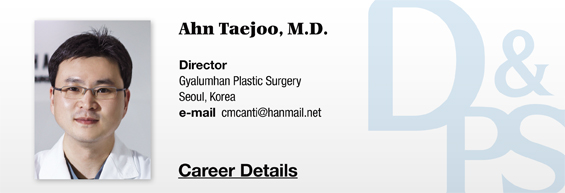Other methods used in nasal tip elevation include Aloderm and dermal fat graft. In some cases, costal cartilage can be used as needed. Besides the above methods using ear cartilage or septal cartilage, shield graft and onlay graft are also used for elevating the nasal tip (Image 6).
.jpg)
Image 6. Shield graft using ear cartilage. If the thicker area is shaved carefully, the cartilage forms a slight bend toward the top and may provide onlay graft effect.
[Advertisement] MAGNUM(Q-switched Nd:YAG Laser) – Manufacturer: (www.i-dana.com)]
To provide additional elevation and prevent depression of the harvested tissues (which can occur in a smile), I prefer removing the depressor septi nasi muscle (Image 7).
.jpg)
.jpg)
Image 7. The muscle and soft tissues between both medial crus and alar cartilage are dissected (left). The depressor septi nasi muscle is removed (right).
Methods and materials used in nose bridge elevation
Materials used in nose bridge elevation include silicone, Gore-Tex, ear cartilage, costal cartilage, dermal fat, Aloderm and fascia, etc.
Silicone and Gore-Tex are the most frequently used materials in initial surgery. Gore-Tex creates a natural outcome but tends to sink downward with time. Silicone does not have this problem but can create an unnatural appearance. With today’s advanced technology, there are few differences between the two materials but implants have a higher risk of infection. Therefore, patients with infection can benefit more from removing the implant and carrying out the correction with autologous tissues.
As the ear cartilage has insufficient volume, it is often used with fascia. Fascia can be used to wrap the silicone implant to create a more natural outcome in patients with thinner skin. Autologous tissues such as costal cartilage and dermal fat are relatively less susceptible to infection and therefore, safer but can be partially absorbed during engraftment (the initial height of the nasal tip may go down gradually over the first couple of years after surgery). For example, I overcorrect 20-30% using dermal fat graft to determine the appropriate height of the nasal tip in follow-up.
The Septal Approach and Correcting the Curved or Wide Nose Bridge
Endonasal incision can be used as part of septal approach or the incision in open rhinoplasty is used to approach the nasal septum. With a curved or aquiline or wide nose bridge, bone resection may be required. Bone resection can be carried out through a small incision made on the skin, on the nasal mucosa or through the dissected layers in open rhinoplasty.
-To be continued-





















